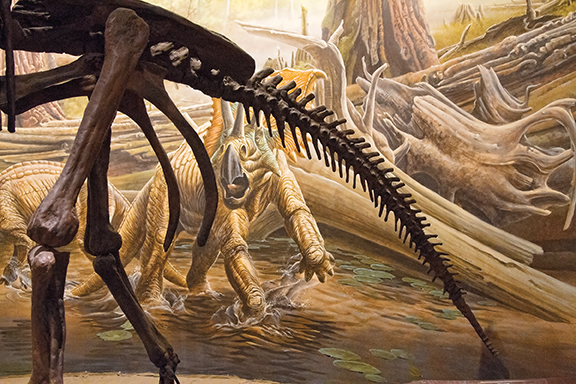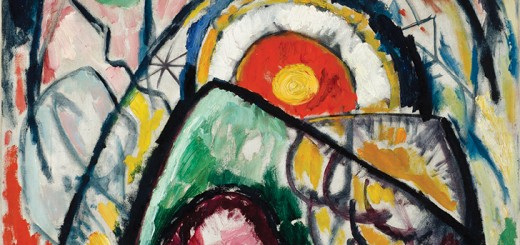Natural History at Morrill Hall

by Caroline Clements
When E.H. Barbour arrived as the University of Nebraska State Museum (UNSM) director in 1891, he brought a passion for science and a desire to share that knowledge with children. In May of 1912 he wrote, “…it often happens that two or three hundred children visit the Nebraska State Museum during the day and we must soon provide a well-equipped child’s museum.” In 1913 he opened the museum’s first Children’s Room. But the museum building of that era fell short of Barbour’s hopes. Together with his friend and museum patron Charles Morrill, he began a campaign to build a new museum in a grand style similar to natural history museums on the coasts.
In 1927, Barbour’s dream of a great natural history museum on campus and a place for youth to explore science came true—Morrill Hall opened to the public. Elephant Hall was the showcase with an impressive collection of ancient elephants, four-tuskers, mastodons, and mammoths. The displays illustrated the diversity of size and species of elephants and their relatives. Science exhibits occupied three floors, and the fourth floor was the home of the art collection. Over the years, exhibits have been added and the art collection moved to the Sheldon Museum of Art.
Current visitors can still experience Barbour’s vision of elephant history as the fossilized ancient elephants continue parading through time in the iconic Elephant Hall. However, visitors to Morrill Hall today will also experience several galleries with hands-on exploration of science that would likely astonish and please Barbour were he able to see them.
“Dr. E.H. Barbour believed passionately in educating youth,” said current UNSM director Susan Weller. “He led tours of school groups and understood the power of museum exhibits to inspire curiosity in children about the natural world. I believe he would be proud of where we are today.”
Located on the same level as Elephant Hall, visitors of all ages enjoy exploring the galaxy through shows in the museum’s Mueller Planetarium. Added in 1958, the Planetarium has taken thousands of viewers on journeys through time and space.
A perennial favorite for visiting families is the Dr. Paul and Betty Marx Science Discovery Center located on the museum’s first floor. It’s the present-day reimagining of Barbour’s 1913 “Children’s Room.” Kids can dig for fossils in a recreated paleontology work site; examine different fossils, stones, and creatures; read a good book in the story nook; test their powers of observation with a sniff and guess the smell station; enjoy a drawing station; and more.
Another popular stop are the gems and mineral displays located on the third floor, including the Bayard meteorite found near Chadron. Nearby, the Cooper Gallery hosts a biannual rotation of temporary exhibits on a variety of topics. Each exhibit includes a variety of family friendly hands-on science and learning activities. First Peoples of the Plains helps visitors understand current contributions of Native Americans to Nebraska as part of our community, as well as how historically Native American Tribes made their living before and during contact with European settlers.
In February 2019, Morrill Hall completed a major renovation—Cherish Nebraska. This Smithsonian-inspired exhibit embraces Barbour’s vision of bringing the best of museums to Nebraska and encompasses the entirety of Morrill Hall’s top floor. Here visitors can dissect creatures and search for parasites via a digital touch-table, learn about climate on a 5-foot diameter show globe, or build an atlatl to hunt ancient mammals at a video game-style kiosk. Pull-out drawers with touchable objects litter all the galleries. In the Science Exploration Zone visitors are encouraged to examine provided fossils, feathers, bugs and more under microscopes. Museum researchers work on actual specimens in a Visible Lab where guests can watch their progress and ask questions.
A variety of monthly programs like ‘Sunday with a Scientist’ and ‘Investigate Saturday Science Lab’ provide additional in-person opportunities for museum goers to connect with University of Nebraska-Lincoln faculty and other researchers in a casual and fun environment. However, Morrill Hall’s galleries and educational programs are also available online. A visitor can plan a visit with the virtual museum portal (museum.unl.edu/virtualvisit) or a school can visit remotely with an educator-guided field trip (museum.unl.edu/education).
“Informal learning environments, like the Museum, are powerful in their ability to inspire curiosity in people of all ages,” said Emily Osberg-Brown, UNSM’s education supervisor. “Our family, adult, and school programs tap into that natural curiosity by providing unique opportunities for individuals all over the state, country, and world to engage more deeply with science and world cultures.”
While visitors to Morrill Hall have a lot to be excited about, and plenty of opportunities to engage in natural history and world cultures exploration, the museum continues to look to the future. Visitors should expect to find future innovations both in person and online every year at Morrill Hall.














Recent Comments